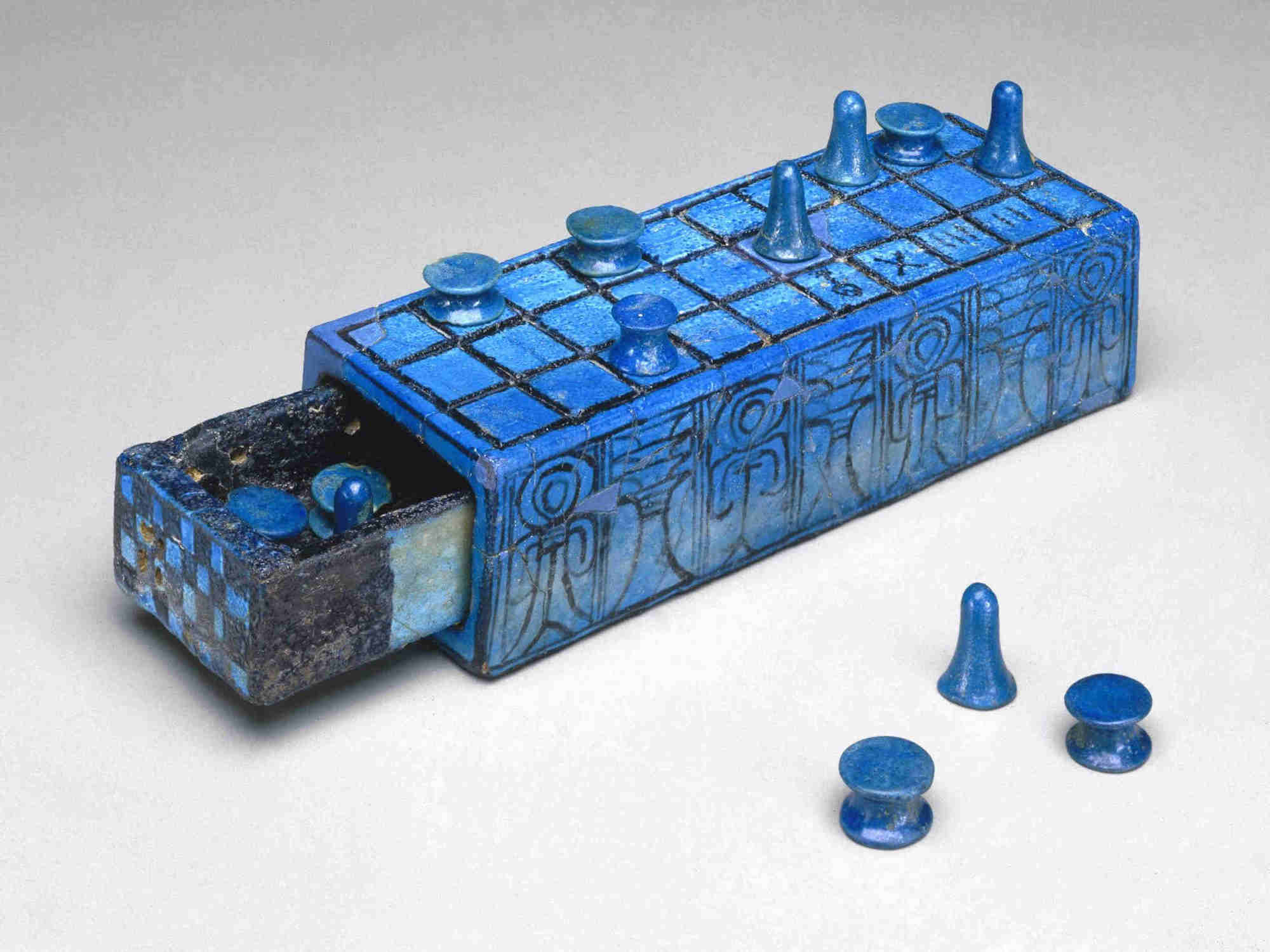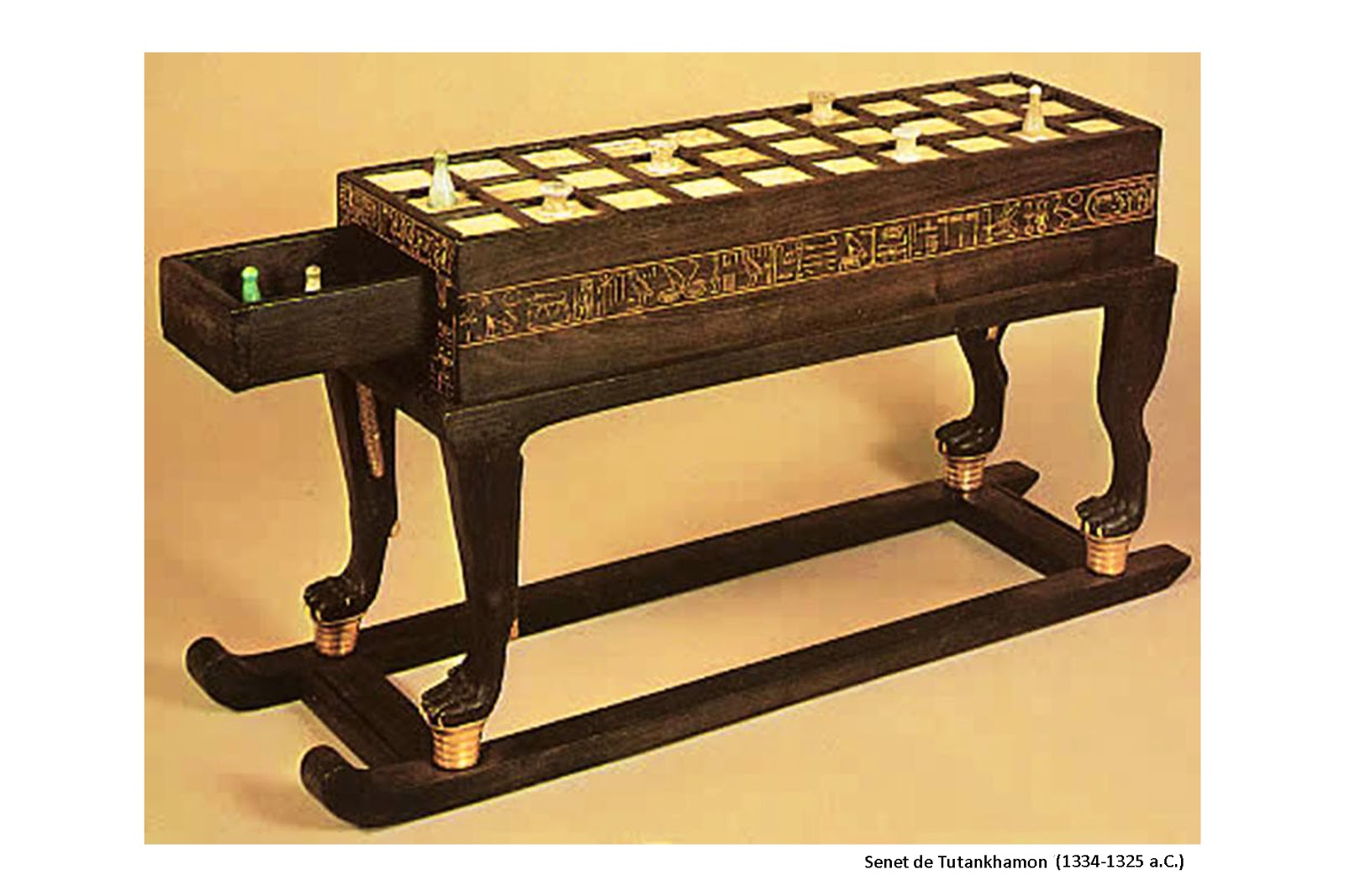O Senet é um dos mais antigos jogos de tabuleiro conhecidos. Senet, cujo nome significa “Jogo de Passagem” era um jogo de tabuleiro egípcio, dos períodos pré-dinástico e antigo, extremamente popular em todas as camadas da sociedade. Muitos historiadores creem que este seja um antepassado do gamão. O mais antigo hieróglifo representando um jogo de Senet é datado entre 3500 e 3100 a.C., o que faz dele o jogo de tabuleiro mais antigo registado pelo homem. Tabuleiros de aproximadamente 2650 a.C. estão registrados em tumbas egípcias. Nunca foram encontradas regras para o Senet, seja em papiros ou em paredes de tumbas. Acredita-se que, pelo fato de ter sido tão popular, ele tenha sido ensinado exclusivamente de um jogador para outro, sem necessidade de regras escritas. Ainda assim, com base em pinturas do jogo em tumbas, nas referências feitas a ele na escrita egípcia e olhando para os seus descendentes modernos, como o gamão, historiadores criaram o que se acredita ser a mais próxima reconstrução das regras de Senet.
:: Senet: Play Store (Android)
Há mais de uma opção. Testei este jogo aqui.
:: Senet: LuduScience
Site em português de Portugal. Além de breve apresentação, as regras podem ser baixadas em formato pdf. Confira, no menu, outros jogos antigos em “Jogos tradicionais”.
:: Como jogar Senet: Mitra Criações
Vídeo que ensina regras possíveis para o Senet. Publicado em 26 de março de 2016. Em português.
:: Senet: Board and Pieces
Site sobre jogos abstratos. História da descoberta do jogo e explicação detalhada, com desenhos, de como jogar. Há, neste site, uma bibliografia. Em inglês.
:: Senet – Game of 30 Squares: Ancient Games
Site de Eli Gurevich. História do jogo e explicação de como jogar. Há também um blog sobre jogos antigos. Em inglês.
:: The Rules of Senet: Masters Traditional Games
Traz as regras do jogo e suas variações, discutindo duas ou três possibilidades. Há regras para vários jogos tradicionais de tabuleiro aqui. Confira também a página Ancient & Historical Board Games. Em inglês.
:: 98 imagens de Senet: Blog de Dmitriy Skiryuk (Дмитрий Скирюк)
Estas imagens estão no blog de Dmitriy Skiryuk, um reconstrutor russo de jogos. As legendas podem ser traduzidas do russo para o português com o auxílio do Google Tradutor.
:: How Senet Works: HowStuffWorks
Como o Senet funciona? Texto de Laurie L. Dove. Publicado em 4 de abril de 2012. Em inglês.
Trecho de PICCIONE, P. A. In Search of the Meaning of Senet. Archaeology, vol. 33, n. 4 – July/August 1980 – p. 55-58 [em pdf aqui]:
Senet began as a, strictly secular game and its evolution can be analyzed in a practical as well as mystical sense. Historically, senet made it first known appearance in the Third Dynasty mastaba or tomb of Hesy-re, the overseer of the royal scribes of King Djoser at Saqqara, dating to approximately 2686 BC. Unidentified senet-like boards have also been found in Predynastic and First Dynasty burials at Abydos and Saqqara and date to about 3500-3100 BC. These and a number of First Dynasty (3100 BC) senet board hieroglyphics indicate that the game may be even older. Annotated depictions of people playing the game also appear on the walls of later Old Kingdom (2686-2160 BC) mastabas among other daily life scenes
Trecho de CRIST, W. ; DUNN-VATURI, A-E ; DE VOOGT, A. Ancient Egyptians at Play: Board Games Across Borders. London: Bloomsbury, 2016, 232 p. – ISBN 9781474221177:
Perhaps the best-known board game from ancient Egypt, senet, also appears in the offering list in Prince Rahotep’s tomb. As it was for mehen, this is the oldest known inscription offering the name of this game that is well attested in New Kingdom contexts. Much like mehen, this game also appears to have held strong connotations with the afterlife. The word zn.t means “passing” in Egyptian, and though any specific religious meaning the game may have held is unclear before the New Kingdom, its name does suggest at least a similar connection with the passing of the ba through the duat that is made explicit in the Book of the Dead. Piccione believes the full name of the game, zn.t n.t hb, “the passing game,” comes from the nature of gameplay where the pieces pass each other on the board. A canonical senet board is between 12 and 55 cm long, laid out in three rows of ten playing spaces, often with certain spaces marked, likely indicating a special outcome during the play of the game, as is shown below. Piccione points out that the name senet is only directly attributed to this pattern of spaces in the New Kingdom, and that Egyptologists have assumed that, when it appears in earlier texts, it refers to the same game. Without any evidence to suggest the name was once used for a different game, it is Piccione’s judgment the name senet referred to the same game in the Old and Middle Kingdoms as it did in the New Kingdom. The origins of senet in Egypt are confusing as there are no intact game boards that date before the Fifth Dynasty, though fragmentary boards, playing pieces and textual and representational art have been found to suggest its earlier existence (…) Toward the end of the Second Intermediate Period [nota: 1640-1550 a.C. – dinastias XV-XVII], senet game boxes appear in the archaeological record, though they probably existed earlier. While senet only appears in the material record as slabs or graffiti prior to the Second Intermediate Period, beginning in the Seventeenth Dynasty game boxes start to appear in Egypt.


